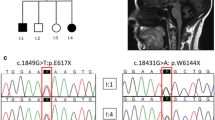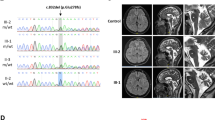Abstract
We have recently identified missense mutations in prodynorphin (PDYN), the precursor to dynorphin opioid peptides, as the cause for spinocerebellar ataxia (SCA23) in Dutch ataxia cases. We report a screen of PDYN for mutations in 371 cerebellar ataxia cases, which had a positive family history; most are of French origin. Sequencing revealed three novel putative missense mutations and one heterozygous two-base pair deletion in four independent SCA patients. These variants were absent in 400 matched controls and are located in the highly conserved dynorphin domain. To resolve the pathogenicity of the heterozygous variants, we assessed the peptide production of the mutant PDYN proteins. Two missense mutations raised dynorphin peptide levels, the two-base pair deletion terminated dynorphin synthesis, and one missense mutation did not affect PDYN processing. Given the outcome of our functional analysis, we may have identified at least two novel PDYN mutations in a French and a Moroccan SCA patient. Our data corroborates recent work that also showed that PDYN mutations only account for a small percentage (~0.1 %) of European SCA cases.

Similar content being viewed by others
References
Durr A (2010) Autosomal dominant cerebellar ataxias: polyglutamine expansions and beyond. Lancet Neurol 9:885–894
Bakalkin G, Watanabe H, Jezierska J, Depoorter C, Verschuuren-Bemelmans C, Bazov I, Artemenko KA, Yakovleva T, Dooijes D, van de Warrenburg BP, Zubarev RA, Kremer B, Knapp PE, Hauser KF, Wijmenga C, Nyberg F, Sinke RJ, Verbeek DS (2010) Prodynorphin mutations cause the neurodegenerative disorder spinocerebellar ataxia type 23. Am J Hum Genet 87:593–603
Kobayashi H, Abe K, Matsuura T, Ikeda Y, Hitomi T, Akechi Y, Habu T, Liu W, Okuda H, Koizumi A (2011) Expansion of intronic GGCCTG hexanucleotide repeat in NOP56 causes SCA36, a type of spinocerebellar ataxia accompanied by motor neuron involvement. Am J Hum Genet 89:121–130
Wang JL, Yang X, Xia K, Hu ZM, Weng L, Jin X, Jiang H, Zhang P, Shen L, Guo JF, Li N, Li YR, Lei LF, Zhou J, Du J, Zhou YF, Pan Q, Wang J, Li RQ, Tang BS (2010) TGM6 identified as a novel causative gene of spinocerebellar ataxias using exome sequencing. Brain 133:3510–3518
Hekman KE, Yu GY, Brown CD, Zhu H, Du X, Gervin K, Undlien DE, Peterson A, Stevanin G, Clark HB, Pulst SM, Bird TD, White KP, Gomez CM (2012) A conserved eEF2 coding variant in SCA26 leads to loss of translational fidelity and increased susceptibility to proteostatic insult. Hum Mol Genet 21:5472–5483
Duarri A, Jezierska J, Fokkens M, Meijer M, Schelhaas HJ, den Dunnen WF, van Dijk F, Verschuuren-Bemelmans C, Hageman G, van de Vlies P, Kusters B, van de Warrenburg BP, Kremer B, Wijmenga C, Sinke RJ, Swertz MA, Kampinga HH, Boddeke E, Verbeek DS (2012) Mutations in potassium channel KCND3 cause spinocerebellar ataxia type 19. Ann Neurol 72:870–880
Lee YC, Durr A, Majczenko K, Huang YH, Liu YC, Lien CC, Tsai PC, Ichikawa Y, Goto J, Monin ML, Li JZ, Chung MY, Mundwiller E, Shakkottai V, Liu TT, Tesson C, Lu YC, Brice A, Tsuji S, Burmeister M, Stevanin G, Soong BW (2012) Mutations in KCND3 cause spinocerebellar ataxia type 22. Ann Neurol 72:859–869
Akil H, Watson SJ, Young E, Lewis ME, Khachaturian H, Walker JM (1984) Endogenous opioids: biology and function. Annu Rev Neurosci 7:223–255
Fawcett K, Mehrabian M, Liu YT, Hamed S, Elahi E, Revesz T, Koutsis G, Herscheson J, Schottlaender L, Wardle M, Morrison PJ, Morris HR, Giunti P, Wood N, Houlden H (2012) The frequency of spinocerebellar ataxia type 23 in a UK population. J Neurol [Epub ahead of print]
Fogel BL, Lee JY, Lane J, Wahnich A, Chan S, Huang A, Osborn GE, Klein E, Mamah C, Perlman S, Geschwind DH, Coppola G (2012) Mutations in rare ataxia genes are uncommon causes of sporadic cerebellar ataxia. Mov Disord 27:442–446
Schicks J, Synofzik M, Beetz C, Schiele F, Schols L (2011) Mutations in the PDYN gene (SCA23) are not a frequent cause of dominant ataxia in Central Europe. Clin Genet 80:503–504
Nikoshkov A, Hurd YL, Yakovleva T, Bazov I, Marinova Z, Cebers G, Pasikova N, Gharibyan A, Terenius L, Bakalkin G (2005) Prodynorphin transcripts and proteins differentially expressed and regulated in the adult human brain. Faseb J 19:1543–1545
Yakovleva T, Bazov I, Cebers G, Marinova Z, Hara Y, Ahmed A, Vlaskovska M, Johansson B, Hochgeschwender U, Singh IN, Bruce-Keller AJ, Hurd YL, Kaneko T, Terenius L, Ekstrom TJ, Hauser KF, Pickel VM, Bakalkin G (2006) Prodynorphin storage and processing in axon terminals and dendrites. Faseb J 20:2124–2126
Day R, Akil H (1989) The posttranslational processing of prodynorphin in the rat anterior pituitary. Endocrinology 124:2392–2405
Kuzmin A, Madjid N, Terenius L, Ogren SO, Bakalkin G (2006) Big dynorphin, a prodynorphin-derived peptide produces NMDA receptor-mediated effects on memory, anxiolytic-like and locomotor behavior in mice. Neuropsychopharmacology 31:1928–1937
Marinova Z, Vukojevic V, Surcheva S, Yakovleva T, Cebers G, Pasikova N, Usynin I, Hugonin L, Fang W, Hallberg M, Hirschberg D, Bergman T, Langel U, Hauser KF, Pramanik A, Aldrich JV, Graslund A, Terenius L, Bakalkin G (2005) Translocation of dynorphin neuropeptides across the plasma membrane. A putative mechanism of signal transmission. J Biol Chem 280:26360–26370
Tan-No K, Takahashi H, Nakagawasai O, Niijima F, Sato T, Satoh S, Sakurada S, Marinova Z, Yakovleva T, Bakalkin G, Terenius L, Tadano T (2005) Pronociceptive role of dynorphins in uninjured animals: N-ethylmaleimide-induced nociceptive behavior mediated through inhibition of dynorphin degradation. Pain 113:301–309
Acknowledgments
We thank the participating family members for their cooperation, Sylvie Forlani, Fabien Lesne, Kamila Karpinska, and Bianca van Wijk for technical assistance. This work was supported by a Rosalind Franklin Fellowship from the University of Groningen and the Swedish Science Council, Swedish Council for Working Life and Social Research, the European Union 6th PCRD (to the EUROSCA consortium), the association Connaitre les Syndrome cérébelleux (to the SPATAX network) and an Uppsala University Fellowship.
Conflicts of interest
The authors report no disclosures.
Author information
Authors and Affiliations
Corresponding author
Rights and permissions
About this article
Cite this article
Jezierska, J., Stevanin, G., Watanabe, H. et al. Identification and characterization of novel PDYN mutations in dominant cerebellar ataxia cases. J Neurol 260, 1807–1812 (2013). https://doi.org/10.1007/s00415-013-6882-6
Received:
Revised:
Accepted:
Published:
Issue Date:
DOI: https://doi.org/10.1007/s00415-013-6882-6




